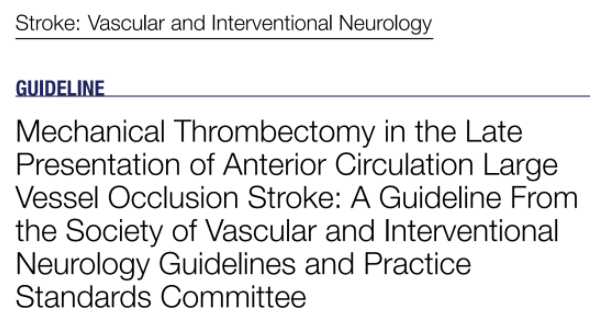查看更多
密码过期或已经不安全,请修改密码
修改密码
壹生身份认证协议书
同意
拒绝

同意
拒绝

同意
不同意并跳过





作者:南京大学神经病学研究所 刘锐

在离最后一次确诊病例6~24小时内出现近端前循环LVO且在DAWN或DEFUSE 3试验中定义的临床影像不匹配的患者,推荐EVT。
(13/13票)专家组一致同意支持这项建议。
在近端前循环LVO距离上次所知的井6至24小时的患者中,NCCT可作为评估梗死面积的唯一成像方式,特别是当CTP或MRI的获取受限或其获取将导致治疗的严重延误时。
(10/13票)咨询委员会以多数意见(>50%)支持这项建议。
对于疑似LVO的患者,在最后已知的井的6~24小时内出现,如果运输时间相对于最近的卒中中心不会延迟15分钟,则将患者直接送往EVT执行中心可能是合理的。
(11/13票)评审小组达成多数共识(>75%,EO-C标准)支持这项建议。
在离最后一次确诊病例6~24小时内出现近端前循环LVO的患者是EVT的候选患者,使用清醒镇静或全身麻醉都是合理的。
(6/11票)咨询委员会以多数意见(>50%)支持这项建议。
对于迟窗LVO患者,成功再灌注(TICI2b/3)后,将收缩压降低并维持在≤140mmHg的目标可能是合理的。
(13/13票)专家组一致同意支持这项建议。
在离上次所知6~24小时内出现近端前循环LVO的患者,在延长窗口的EVT中使用球囊引导导管是合理的。
(7/11票)咨询委员会以多数意见(>50%)支持这项建议。
在离上次所知6~24小时内出现近端前循环LVO的患者,建议使用支架取栓。
(13/13票)咨询委员会以多数意见(>50%)支持这项建议。
在离最后一次确诊病例6~24小时内出现近端前循环LVO的患者,一线接触吸入或联合吸入技术与一线支架回收技术一样有效。
(13/13票)咨询委员会以多数意见(>50%)支持这项建议。
对于NIHSS评分<6且近端前循环LVO的患者,EVT与药物治疗相比的有效性尚不清楚。
(6/11票)咨询委员会以多数意见(>50%)支持这项建议。
在离最后的已知6~24小时内出现病前残疾并伴有近端前循环LVO的患者,如果满足其他MT标准,EVT可能是合理的。
(8/11票)咨询委员会以多数意见(>50%)支持这项建议。
对于年龄≥80岁的患者,在离上一个已知的6~24小时内出现近端前循环LVO,如果满足其他既定的MT标准,EVT是合理的。
(6/11票)咨询委员会以多数意见(>50%)支持这项建议。
对于前循环LVO在最后一次确诊后6~24小时内出现的患者,无论其表现如何(有目击者、白天无目击者、醒来时无目击者的中风),建议采用EVT。
(8/11票)咨询委员会以多数意见(>50%)支持这项建议。
前循环LVO在最后一次确诊后6~24小时内出现,经CT或DWI ASPECTS 2~5定义为大面积核心梗死的患者,建议参加正在进行的临床试验。
(12/13票)咨询委员会以多数意见(>50%)支持这项建议。
如果LVO表现超过24小时,且CT灌注成像或MRI显示目标不匹配,则可考虑EVT。
(12/13票)咨询委员会以多数意见(>50%)支持这项建议。
在LVO出现超过24小时的患者中,尚不清楚通过NCCT选择EVT是否会带来益处。
(11/13票)咨询委员会以多数意见(>50%)支持这项建议。
Patient selection
In patients presenting within 6 to 24 h from last known well with proximal anterior circulation LVO and with clinical–imaging mismatch as defifined in the DAWN or DEFUSE 3 trials, EVT is recommended.
(COR-1; LOE A)
(13/13 votes) There was unanimous consensus among the panel to support this recommendation.
In patients with proximal anterior circulation LVO 6 to 24 h from last known well, NCCT can be used as the sole imaging modality to evaluate infarct size, particularly when access to CTP or MRI is limited or if their performance would incur substantial delay to treatment.
(COR-2a; LOE B-NR)
(10/13 votes) There was majority consensus (>50%) among the panel to support this recommendation.
Systems of care
In patients with a suspected LVO presenting within the 6 to 24 h of last known well, it may be reasonable to transport the patient directly to an EVT-performing center if transport time would not be delayed by >15 min relative to the nearest stroke center.
(COR-2b; LOE EO-C)
(11/13 votes) There was majority consensus (>75%, EO-C criteria) among the panel to support this recommendation.
Peri-procedural Considerations
In patients presenting within 6 to 24 h from last known well with a proximal anterior circulation LVO who are candidates for EVT, the use of either conscious sedation or general anesthesia is reasonable.
(COR-2a; LOE B-NR)
(6/11 votes) There was majority consensus (>50%) among the panel to support this recommendation.
In patients with late-window LVO, following successful reperfusion (TICI 2b/3), reduction, and maintenance of systolic BP to a target of ≤140 mm Hg may be reasonable.
(COR-2b; LOE B-NR)
(13/13 votes) There was unanimous consensus among the panel to support this recommendation.
In patients presenting within 6 to 24 h from last known well with a proximal anterior circulation LVO, use of a balloon-guided catheter is reasonable during EVT in the extended window.
(COR-2b; LOE B-NR)
(7/11 votes) There was majority consensus (>50%) among the panel to support this recommendation.
In patients presenting within 6 to 24 h from last known well with a proximal anterior circulation LVO, the use of a stent retriever is recommended.
(COR-1; LOE A)
(13/13 votes) There was majority consensus (>50%) among the panel to support this recommendation.
In patients presenting within 6 to 24 h from last known well with a proximal anterior circulation LVO, fifirst-line contact aspiration or combined aspiration technique can be as effective as the fifirst-line stent retriever technique.
(COR-2a; LOE B-R)
(13/13 votes) There was majority consensus (>50%) among the panel to support this recommendation.
Special considerations
In patients presenting within 6 to 24 h from last known well with NIHSS scores <6 and proximal anterior circulation LVO, the effectiveness of EVT compared with medical management is unknown.
(COR-2b; LOE C-LD)
(6/11 votes) There was majority consensus (>50%) among the panel to support this recommendation.
In patients with premorbid disability presenting within 6 to 24 h from last known well with a proximal anterior circulation LVO, EVT may be reasonable if other MT criteria are met.
(COR-2b; LOE B-NR)
(8/11 votes) There was majority consensus (>50%) among the panel to support this recommendation.
In patients aged ≥80 years presenting within 6 to 24 h from last known well with a proximal anterior circulation LVO, EVT is reasonable if other established criteria for MT are met.
(COR-2a; LOE B-NR)
(6/11 votes) There was majority consensus (>50%) among the panel to support this recommendation.
In patients with anterior circulation LVO presenting within 6 to 24 h of last known well, EVT is recommended regardless of the presentation (witnessed, daytime unwitnessed, wake-up unwitnessed stroke).
(COR-1; LOE A)
(8/11 votes) There was majority consensus (>50%) among the panel to support this recommendation.
In patients with anterior circulation LVO presenting within 6 to 24 h of last known well with large core infarct as defifined by CT or DWI ASPECTS 2 to 5, enrollment in ongoing clinical trials is recommended.
(COR-2b; LOE B-NR)
(12/13 votes) There was majority consensus (>50%) among the panel to support this recommendation.
In patients with LVO presenting beyond 24 h with target mismatch profifiles based on CT perfusion imaging or MRI, EVT may be considered.
(COR-2b; LOE C-LD)
(12/13 votes) There was majority consensus (>50%) among the panel to support this recommendation.
In patients with LVO presenting beyond 24 h, it is unknown whether selection by NCCT to EVT confers benefifit.
(COR-2b; LOE C-LD)
(11/13 votes) There was majority consensus (>50%) among the panel to support this recommendation.
来源:第67病区
二甲双胍、碘过敏……CT、CTA等检查前需要有哪些注意事项?
徐运:缺血性卒中个体化抗血小板治疗及评估丨CSA&TISC2022
急性脑出血患者收缩压 180 mmHg,紧急降至多少才安全?
ISC 2022|续写新篇章 —— “替奈普酶”精彩继续……
神经影像问答:脑干梗死后华勒氏变性(WD)有什么影像特点和临床表现?
查看更多